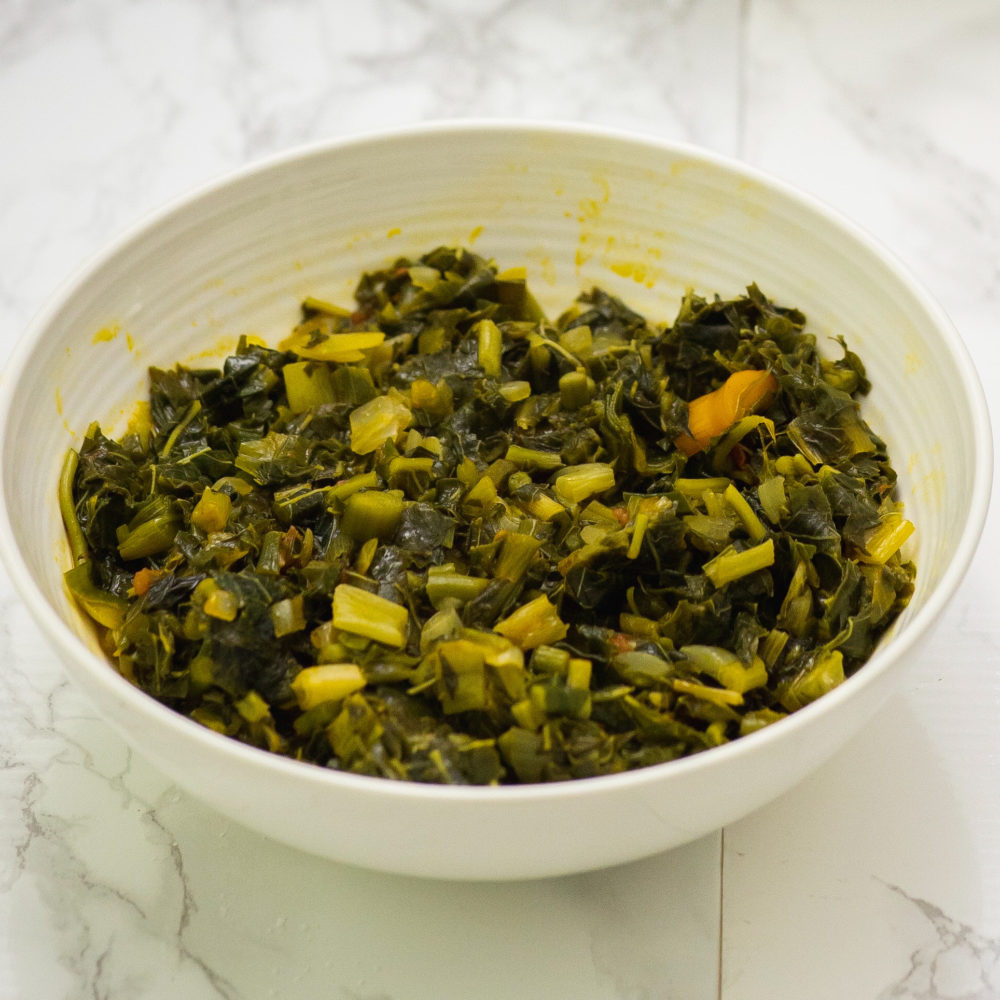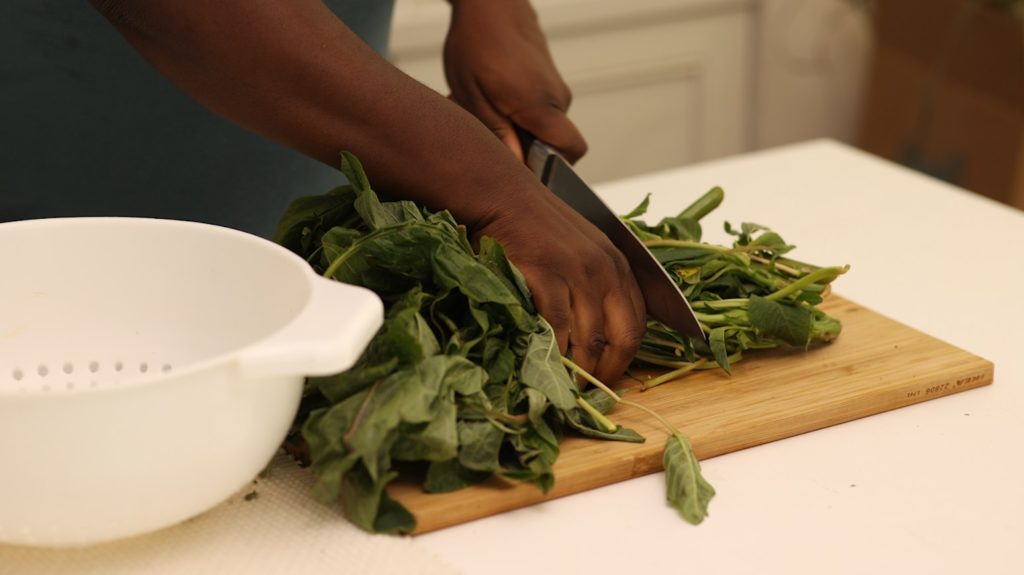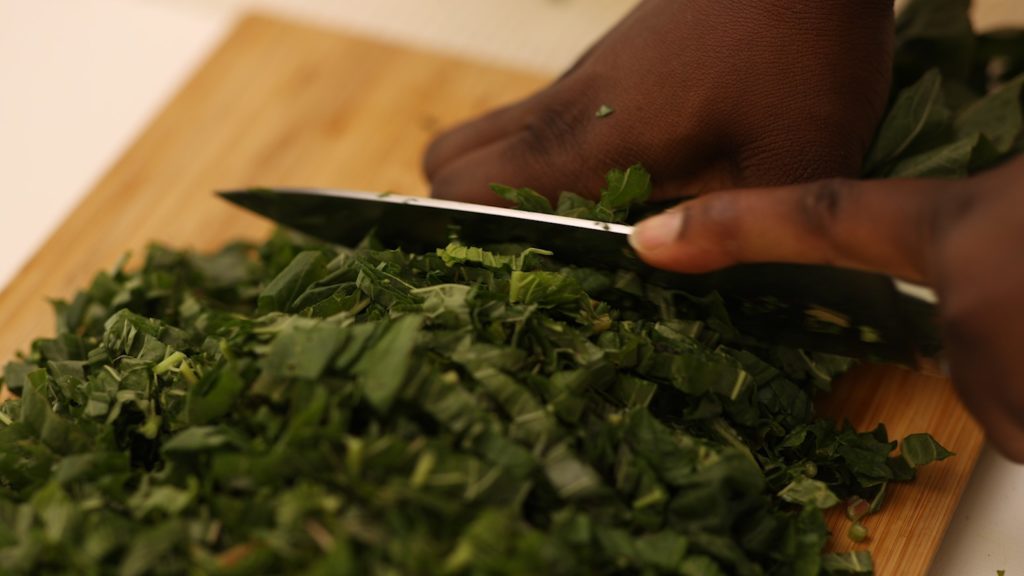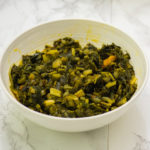
Amaranth leaves stew recipe is one of my favourite vegetable stew recipes. It is a leafy green and is normally grown in Africa, Asia and the Caribbean. It is known under different names throughout Africa (biteku-teku, efo tete, ndunda). Due to immigration, you can easily find this vegetable in an Asian or international market in America. The plant is considered to be a superfood due to its nutrients and the health benefits from its leaves and seeds.
I grew up eating this vegetable as a stew mostly. My mom would put onions, green onions, tomatoes and a little bit of palm oil in it. I could eat just this stew by itself.
What do amaranth leaves taste like?

Amaranth is similar to spinach but with a deeper flavour. Unlike spinach, I cook the leaves with a small part of the stem. The leaves do not wilt as easily as spinach under hot water.
What are its health benefits?
Amaranth leaves are a superfood. They are packed with twice the amount of vitamin C as spinach. They are a good source of potassium, which can reduce the risk of strokes and improve brain function. It also contains magnesium, which helps reduce the risk of hypertension; and they are full of fiber and iron. They are also easier to digest than kale. So, if you are not a fan of kale, you should try amaranth leaves.
How can you eat amaranth leaves?
Amaranth leaves are versatile greens that can be eaten in soup, salad, stew or stir fry. Its seeds are also edible and can be cooked as hot cereal.
How do you make amaranth leaves stew?

This is a classic amaranth leaves stew recipe that does not need any improvement. You can add dry fish to it, which makes it even more delicious. I ran out of fish at the time when I was making this recipe. But it’s a good add-on to the recipe. I added a yellow habanero pepper and mint leaves to add another layer of flavour which brought this dish to another level. If you do not like spicy food, make sure to remove the habanero pepper before it pops.
Here are the steps:
1. Chop thinly the amaranth from where the leaves start. Discard the big stem.

2. Wash the leaves thoroughly in a colander
3. First, put the leaves in a sauce pan. Keep in mind that they will wilt as they are cooking.
4. Add the water to the leaves and place it on medium high on the stove.
5. Add the onion, green onions, tomato, mint leaves, habanero pepper, palm oil, salt.

6. Do not stir at first.
7. After 5 min, mix everything well.
8. Let it boil for 20-25 min.
9. The leaves should be tender and wilted.
You might also like:
Sorrel (Ngayi ngayi) salad recipe
African beignets (puff puff) with mango sauce
Gluten free mango cake with cassava and corn flour
Print
Amaranth leaves (biteku teku) stew recipe
- Prep Time: 15 min
- Cook Time: 25 min
- Total Time: 40 min
- Yield: 6 1x
- Category: Side dish
- Method: Boiling
- Cuisine: African
- Diet: Vegan
Description
The best stew for any season. This recipe works best with fresh leaves.
Ingredients
- 2 pounds of amaranth leaves (chopped)
- 15 greens onions (chopped)
- 1 onion (chopped)
- 1 medium tomato (chopped)
- ½ cup of mint leaves (chopped)
- ½ yellow pepper (chopped)
- 1 yellow habanero pepper
- ½ cup of palm oil
- ½ tsp of salt
- 2 cups of water
Instructions
- Start chopping thinly the amaranth from where the leaves start. Discard the big stem. (photo)
- Wash them thoroughly in a colander
- Put the leaves in a sauce pan first. Keep in mind that they will wilt as they are cooking.
- Add the water and put it on medium high on the stove.
- Add the onion, green onions, tomato, mint leaves, habanero pepper, palm oil, salt. (photo)
- Do not stir at first
- After 5 min, mix everything well.
- Let it boil for 20-25 min.
- The leaves should be tender and wilted.
Notes
Add a little bit of water if you see that is very little water left. The leaves should not have water covering them.
Very detailed intstructions along with pictures. Thank you for sharing!
Thank you!
Thanks for recipe! Can you please advise me where to find amaranth leaves ? If possible? I will be very great full! Thanks for sharing your recipe!
You might find them in an asian store or international market depending where you live.
Easy recipe with your instructions. I substituted palm for coconut oil. No habanero pepper so I put a few drops to taste of a habanero salsa from Mexico. I used stewed tomatoes from my garden and added a fresh one to add chunks of red. This was so tasty! I feel very nourished. Thank you for broadening my knowledge and expanding my options with greens.
Wow! That sounds tasty! I have never tried with coconut oil, I should it it a try too.
I am so happy that you liked the recipe. 🙂
Hi! I am definitely going to try this recipe. I gave it a 5 star rating even still because looking at the ingredients I KNOW I will love it. It sounds strikingly similar to one that I had at an Ethiopian restaurant. I found your site while writing a blog about breads around the world on my travel site. I was writing about Injera and as I was writing I recalled the dish I had eaten and had to research it. I am quite certain it is biteku teku. I put a link to this page in the blog just in case someone else was curious. Now I need to find some Amaranth leaves!
Hi!
Amaranth leaves are eaten throughout the sub saharan region in Africa. I wouldn’t be surprised if you had tasted them before. I enjoyed reading the article about sauces on your blog.:) You can find fresh leaves in asian market (depending on where you live).
Let me know how it turns out if you get to try the recipe!